Cite this document
(“Bram Stokers Dracula (1897): A Modern Novel of its Time Essay”, n.d.)
Retrieved from https://studentshare.org/environmental-studies/1420792-bram-stokers-dracula-1897-a-modern-novel-of-its-time
Retrieved from https://studentshare.org/environmental-studies/1420792-bram-stokers-dracula-1897-a-modern-novel-of-its-time
(Bram Stokers Dracula (1897): A Modern Novel of Its Time Essay)
https://studentshare.org/environmental-studies/1420792-bram-stokers-dracula-1897-a-modern-novel-of-its-time.
https://studentshare.org/environmental-studies/1420792-bram-stokers-dracula-1897-a-modern-novel-of-its-time.
“Bram Stokers Dracula (1897): A Modern Novel of Its Time Essay”, n.d. https://studentshare.org/environmental-studies/1420792-bram-stokers-dracula-1897-a-modern-novel-of-its-time.


